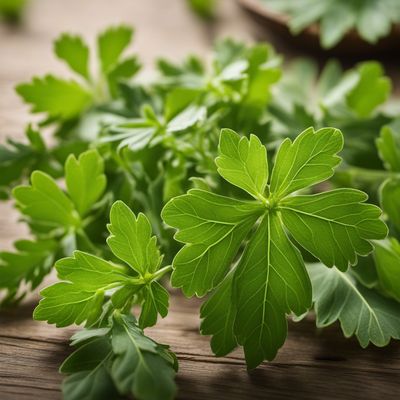
Ingredient
Sweet cicely, dry
The Delicate Herb: Sweet Cicely
Sweet cicely is a perennial herb that belongs to the carrot family. It has fern-like leaves and delicate white flowers, which give way to small, brown seeds. The herb has a sweet, anise-like flavor with hints of licorice and citrus. Its taste is often described as a combination of fennel, anise, and celery. The texture of sweet cicely is soft and tender, similar to parsley or cilantro. Its appearance adds a touch of elegance to dishes, with its feathery leaves and delicate flowers.
Origins and history
Sweet cicely has a rich history dating back to ancient times. It was highly valued by the Greeks and Romans for its medicinal properties and was often used as a natural sweetener. In medieval Europe, sweet cicely was considered a symbol of love and was used in love potions and perfumes. It is native to Europe and Western Asia and has been cultivated for centuries in gardens for both culinary and medicinal purposes.
Nutritional information
Sweet cicely is low in calories and a good source of vitamins A and C. It also contains minerals like potassium, calcium, and iron. Additionally, it has been used in traditional medicine for its potential digestive and diuretic properties.
Allergens
There are no known allergens associated with sweet cicely.
How to select
When selecting dry sweet cicely, look for a product that is fresh and aromatic. The leaves should be green and free from any signs of wilting or discoloration. Avoid any packages that have moisture or clumps, as this may indicate poor quality or improper storage.
Storage recommendations
To maintain the freshness and quality of dry sweet cicely, store it in an airtight container in a cool, dark place. Avoid exposure to heat, moisture, or direct sunlight, as these can degrade the flavor and aroma of the herb. Properly stored, dry sweet cicely can retain its potency for up to a year.
How to produce
Sweet cicely can be grown in a home garden with ease. It prefers a sunny or partially shaded location with well-drained soil. Sow the seeds directly into the ground in early spring or late summer. Keep the soil moist until the seeds germinate, and then thin the seedlings to allow proper growth. Harvest the leaves as needed, and dry them for later use.
Preparation tips
Sweet cicely can be used in a variety of dishes and preparations. It pairs well with fruits, especially berries, and is often used in jams, jellies, and desserts. It can also be added to savory dishes like soups, stews, and sauces to impart a subtle sweetness and herbal aroma. Additionally, sweet cicely can be infused into teas or used as a garnish for cocktails and mocktails.
Culinary uses
Sweet cicely is commonly used in Scandinavian, British, and French cuisines. It is often found in traditional dishes like rhubarb compote, fruit salads, and herbal liqueurs. In Scandinavian countries, it is used to flavor aquavit, a traditional spirit. In British cuisine, sweet cicely is used in cakes, custards, and fruit pies. In France, it is used in herbal teas and as a garnish for fish and seafood dishes.
Availability
Sweet cicely is commonly available in Europe, particularly in countries like Sweden, Norway, the United Kingdom, and France. It can also be found in specialty stores or online retailers that offer a wide range of culinary herbs and ingredients.
More ingredients from this category » Browse all

Hyssop, dry
The Aromatic Herb: Unveiling the Secrets of Dry Hyssop

Bay leaves, dry
Aromatic Leaf of Flavor

Sage, dry
The Timeless Herb: Unveiling the Versatility of Dry Sage

Wormwoods, dry
The Bitter Herb: Wormwoods

Angelica, dry
The Heavenly Herb: Unveiling the Secrets of Dry Angelica

Borage, dry
The Vibrant Herb of Delight

Lavender, dry
The Fragrant Herb: Lavender

Wintergreen leaves, dry
Nature's Minty Delight

Lovage, dry
The Aromatic Herb: Lovage

Tansy and related species, dry
The Golden Herb of Ancient Times

Mints, dry
The Versatile Herb: Unlocking the Aromatic Power of Dry Mints

Thyme, dry
The Essence of Thyme: A Versatile Herb